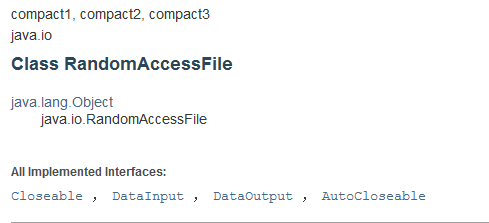Four ways to create objects
- New Object
Open up memory space for storage in heap - Clone Copy Create Object
- Deserialize
Restore the byte sequence to the original Java object - reflex
Serializable and Deserialize
Serialization: A Java object is "transformed" into a sequence of bytes. This facilitates persistent storage to disk, avoids the disappearance of objects from memory after the program runs, and facilitates network transportation and propagation by converting them to byte sequences.
Deserialization: Restores the byte sequence to the original Java object.
Interface for serialization: Serializable
Serializable is a markup interface that does not implement anything but tells the JVM that the current object needs to be serialized.
(The Cloneable interface is also a markup interface and has nothing but tells the JVM that the object needs cloning)
SerialVersionUID is the unique identifier before and after serialization. If no SerialVersionUID has been defined artificially, the compiler will automatically declare one. Generally, no human processing is required.
- Note:
static modifiers will not be serialized
transient modifiers will not be serialized
Demo
Car.java
package com.wdy.stream;
import java.io.Serializable;
public class Car implements Serializable {
/**
*
*/
private static final long serialVersionUID = 1L; //Version information, automatically declared by the compiler. No artificial modification is generally required
private int id;
private String brand;
private String color;
private double price;
public Car() {
}
public Car (int id, String brand, String color, double price) {
this.id = id;
this.brand = brand;
this.color = color;
this.price = price;
}
public int getId() {
return id;
}
public void setId(int id) {
this.id = id;
}
public String getBrand() {
return brand;
}
public void setBrand(String brand) {
this.brand = brand;
}
public String getColor() {
return color;
}
public void setColor(String color) {
this.color = color;
}
public double getPrice() {
return price;
}
public void setPrice(double price) {
this.price = price;
}
@Override
public String toString() {
return "Car [id=" + id + ", brand=" + brand + ", color=" + color + ", price=" + price + "]";
}
}
Output stream writes properties of Car object
package com.wdy.stream;
import java.io.FileNotFoundException;
import java.io.FileOutputStream;
import java.io.IOException;
import java.io.ObjectInputStream;
import java.io.ObjectOutputStream;
/*
* Output stream writes properties of Car object
*/
public class ObjectOutputStreamDemo {
public static void main(String[] args) throws Exception {
ObjectOutputStream out = new ObjectOutputStream(new FileOutputStream("D:\\car.dat")); //Create Input Stream Object Byte Stream Object
Car c = new Car(1, "bmw", "black", 1200000.00);
out.writeObject(c);//Write property
out.close();
}
}
Execution results:

package com.wdy.stream;
import java.io.FileInputStream;
import java.io.ObjectInputStream;
import java.io.IOException;
import java.io.ObjectInputStream;
/*
* Output stream reads out the contents of a file
*/
public class ObjectInputStreamDemo {
public static void main(String[] args) throws Exception {
ObjectInputStream in = new ObjectInputStream(new FileInputStream("D:\\car.dat"));
Car car = (Car) in.readObject();//The method by which.readObject() reads the object reads the Car object. Turn Strongly
System.out.println(car);
}
}
Execution results:

NIO
Java. The full name of nio, java non-blocking 10 - (actually new io), refers to the new api (New IO) provided in JDK version 1.4 and above that provides caching support for all original types except boolean types: data containers that provide non-blocking, highly scalable networks.
Composition of NIO
-
Channel
A channel represents an open connection to an IO device (for example, a file, a socket). If you need to use a NIO system, you need to get the channels used to connect the IO devices and the buffers used to hold the data. Then the buffer is manipulated to process the data.
Channel is more efficient than Stream in IO. Channel can transmit in both directions asynchronously, but must be used with buffer. -
Buffer (Cache)
Buffers are essentially a block of data that can be written to and then read from
Memory for fetching data. This block of memory is packaged as a NIO Buffer object and provides a set of methods for accessing it easily. -
Selector
Allow single-threaded processing of multiple Channel s if your application has multiple connections open
Connect (channel), but each connection has a low traffic, so using the Selector method is easy
Yes.
Selector can detect multiple NIO Channel s to see if read or write events are ready.
Multiple Chanel s can be registered as events to the same Seletor, making it possible to process multiple requests with one thread.
Demo
nio can read and write simultaneously to achieve non-blocking synchronization compared with normal input and output streams. Ordinary streams can block write (read) threads when performing read (write) tasks.
package com.wdy.stream;
import java.io.FileNotFoundException;
import java.io.RandomAccessFile;
import java.nio.ByteBuffer;
import java.nio.channels.FileChannel;
public class NIODemo {
public static void main(String[] args) throws Exception {
String path = Thread.currentThread().getContextClassLoader().getResource("").getPath();
System.out.println(path);
path =path.substring(0, path.length()-4);
System.out.println(path);
String fileName = path+"src/io/file/FileDemo02.java";
RandomAccessFile raf = new RandomAccessFile(fileName, "rw");//Create a NIO read object "rw" to represent readable and writable
FileChannel inChannel = raf.getChannel(); //Open Channel, Open Channel (nio) can read and write simultaneously, non-blocking synchronization compared with normal input and output streams. Normal streams block write threads when performing read (write) tasks
ByteBuffer buffer = ByteBuffer.allocate(64);//Create cache space. Size is confirmed as appropriate
int n = 0;
while((n=inChannel.read(buffer))!=-1) { //Read the contents of the cache through a channel
buffer.flip();//Move to the first location of the cache
while(buffer.hasRemaining()) {//Determine if the cache has data
System.out.print((char)buffer.get()); //Read in bytes. Strong to char
}
buffer.clear();
}
raf.close();
}
}

